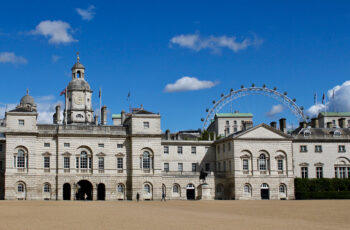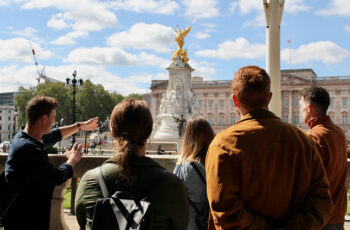With their bright red tunics and their tall bearskins hats the Queen’s Guard is one of London’s most iconic symbols. Unsurprising then that thousands of tourists flock to witness the spectacle of the Changing of the Guard.
A theatrical and musical military ceremony that sees the handover of the responsibility of guarding the Royal Palace. But what is the best way to see this splendid military parade? Here are some tips on where and how to see the changing of the guard.
Who are the Queen’s Guard?
Firstly the Queen’s Guard is not purely ceremonial. They are active members of the British Army and most of them have served overseas. These real soldiers carry real weapons and have a real job to do – protecting the Royal Households. Since the reign of Charles II in the 17th century, they have been responsible for guarding Buckingham Palace, Clarence House and Saint James’ Palace. They are also responsible for guarding the Tower of London, which is still an official royal residence and home to the Crown Jewels.

There are 5 regiments making up the Queen’s Guard. There is a way to identify who is who if you want to impress your friends and family. Always in scarlet red in summer and violet grey in winter, there are small details to help you recognize who is who:
Irish Guards:
Little blue plume sticking out tall bearskin hat. Buttons on tunics are in sets of five
Welsh Guard:
Little white and green plume sticking out the hat. Buttons are in sets of four
Scots Guard:
No plume. Buttons in sets of three
Coldstream Guards:
Red Plume. Buttons in pairs
Grenadier Guards:
White Plume. Single buttons in a line.
What happens during the ceremony?
The Changing of the Guard ceremony started around 1837 when Queen Victoria moved into Buckingham Palace. The ceremony is where one regiment (the Old Guard) ends its shift and hands over to the new regiment (the New Guard).
Accompanied by a military band, the changing of the guard is full of all the pomp and ceremony you would expect of a royal parade, and is quite the musical experience! While you would be right in expecting traditional brass marching music, the royal band has been known to spice things up a bit playing all sorts, from Abba, to Daft Punk to the Game of Thrones soundtrack, as well as classical music and traditional marching tunes.
Each regiment is divided into two, part guarding Buckingham Palace and part at St. James’ further down the Mall. At the end of their two-hour shift, the Old Guard at Buckingham Palace leaves their posts and meet in the courtyard, while the guard at St. James’ march down the Mall to join them. The New Guard arrives from Wellington Barracks and the commanders symbolically hand over the palace keys by bumping fists. Part of the New Guard takes up position outside Buckingham Palace while their comrades march to St. James’ Palace for their shift.

When can I see the Changing of the Guard?
The Changing of the Guard takes places daily in June and July and Monday, Wednesday, Friday and Sunday the rest of the year. The ceremony starts at 11am and lasts 45 minutes (you will want to arrive 15 mins or more early to ensure a good spot and watch the guards preparing). Check out the full schedule here.
Where’s the best place to see the Changing of the Guard?
Most tourists head to the front gates of Buckingham Palace hoping to get the best spot, but the ceremony actually takes place across all three locations.

For the most theatrical way to enjoy this military moment, we suggest starting at Saint James Palace and following the old guards as they march down The Mall to Buckingham Palace. From there you can see both sets of old guards leave as the new guard arrives. Don’t forget to follow the guards towards Wellington Barracks for the final and most impressive part of the ceremony as the guards say farewell before going off duty.




